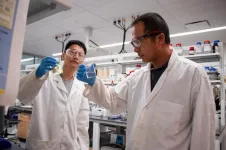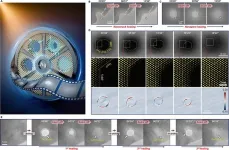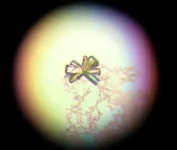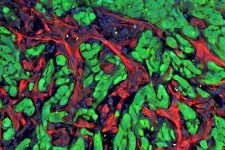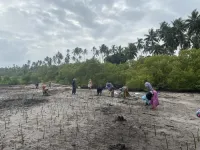(Press-News.org) As the world transitions to cleaner energy sources, the need for energy-relevant metals and critical minerals has surged dramatically. Driven by the rise of electric vehicles and other green technologies, these essential materials are in high demand across the globe.
Metals, such as lithium, cannot be grown. They must be mined or recycled, making this a top priority for researchers in the mining industry. Traditional methods of mining lithium are expensive and can be harmful to the environment, but researchers at Virginia Tech have found a way to minimize this environment impact. They will optimize and scale up this method with a pending Department of Energy grant worth over $1.8 million, including $1.5 million in federal shares.
Wencai Zhang, associate professor in the Department of Mining and Minerals Engineering, is leading this project to recover high-demand metals, such as lithium and rare earth elements, from produced water from the Marcellus Shale in the Appalachian Basin. Produced water is naturally occurring water that comes out of the ground during the production of natural gas and can contain pollutants such as lithium, along with sodium chloride, calcium, and magnesium that cause extremely high salinity levels. Researchers aim to reduce salinity levels and remove pollutants while extracting lithium for other manufacturing applications.
“High-demand metals and minerals, such as lithium, play an essential role in electric vehicle production and are present in virtually every battery worldwide,” said Zhang. “Our goal is to contribute to the supply chain of these critical materials while also making a positive environmental impact. We specifically aim to reduce the environmental consequences that can be associated with produced water.”
The novel approach
Although several studies have been performed on lithium recovery from produced water, a complete process that can produce battery-grade lithium has not yet been developed.
Enter Zhang and his team, who have developed a novel process for achieving beneficial uses of produced water, including valuable mineral recovery and carbon fixation. Their project involves five major phases to treat the produced water and harvest these high-demand minerals.
Phase one: Produced water treatment
Zhang and his team will begin by treating the produced water from the Marcellus Shale in the Appalachian Basin with the aim of removing any solid particles while maintaining minimal loss of valuable minerals.
Phase two: Rare earth elements and critical metals recovery
In order to recover these high-demand minerals, Zhang has developed patented and patent-pending technologies to recover critical minerals from the produced water. The concentration of the minerals in the produced water is too low for efficient recovery, so Zhang’s method, known as staged precipitation, concentrates critical elements from the solution so that they can be efficiently extracted and further refined.
Phase three: Direct lithium recovery
The conventional method of lithium extraction from the earth is costly and requires a significant amount of energy. The researchers will combine a specially designed ion-exchange system, which is used in the separation of substances and is specifically selective for lithium, and a multiple-stage solvent extraction process that has been significantly modified to suit produced water treatment. Zhang and his team’s novel method for direct lithium extraction is cost-effective and less energy-intensive.
Phase four: Carbon mineralization
Produced water contains alkaline earth metals, such as calcium and magnesium, which contribute to the hardness of water, or how usable it is. Zhang and his team will be using carbon mineralization to remove these metals by adding carbon dioxide gas to a solution that contains alkaline earth metals, which then allows carbonate compounds, such as calcium carbonate, to form and settle out of the solution. By turning carbon dioxide and minerals into solid particles, they can then be filtered out of the water.
Phase five: Phyto-microbial treatment
In the final project phase, Zhang and his team will be reducing salinity levels and removing pollutants from the produced water using phyto-microbial treatment, which involves employing plants and their respective microbes to clean up contaminants in the produced water. They will intentionally select certain plants with excellent purification characteristics that might not normally grow in the location of the produced water. These plants and microbes will be tailored to the removal of all contaminants, resulting in cleaner water.
Environmental improvements for the future
The minerals recovered from this project play a critical role in our modern society. With an electric vehicle future on the horizon, Zhang is teaming up with interdisciplinary researchers and industry partners that will contribute their expertise and relevant data for the project. Their partners include
Colleen Doherty, associate professor of molecular and structural biochemistry at North Carolina State University, will lead phase five of the project.
Austin Elements, a battery-recycling company, will lead the effort of phase three and the pre-pilot construction and techno-economics for the commercialization.
EQT Corporation, a leading natural gas producer in the United States with operations in the Appalachian Basin, will provide the team with sufficient produced water for experimental tests.
When collaborating on a project with such significant impacts like cleaner energy and cleaner water, having a shared goal becomes crucial. The research team’s goal for this project happens to benefit our region.
“The Marcellus Shale is a significant geological formation known for its rich deposits of natural gas, particularly shale gas,” said Zhang. “It is located primarily in the Appalachian Basin in the eastern United States, which includes part of Virginia. This project offers the opportunity to unlock additional environmental benefits for this region.
“My knowledge itself cannot solve this issue, so it’s crucial to the project that we have collaborators who have industry relevant knowledge that will make a substantial impact on the project and get the issue resolved."
The potential future impact of this project is substantial, and integrating this research into common practice could significantly enhance the benefits of shale gas production. Shale gas companies operate multiple production sites, often relying on centralized water facilities to collect and distribute water across various locations. Zhang and his team’s technology can be integrated into these facilities to optimize this process.
Treated produced water could also be used as irrigation water in the future, supporting agriculture in the region.
“Our technology not only facilitates the recovery of valuable minerals like lithium, but also ensures that the water remains suitable for shale gas production," Zhang said. "We can also reduce water salinity, providing cleaner water to support agriculture in areas with low water supply."
END
Researcher develops technology to provide cleaner energy and cleaner water
A researcher in Virginia Tech’s College of Engineering has developed a novel method for direct lithium extraction from produced water to contribute to the high demand for electric vehicles and green energy.
2024-09-06
ELSE PRESS RELEASES FROM THIS DATE:
Expect the unexpected: nanoscale silver unveils intrinsic self-healing abilities
2024-09-06
As an innovative concept in materials science and engineering, the inspiration of self-healing materials comes from living organisms that have the innate ability to self-heal. Along with this line, the search for self-healing materials has been generally focused on “soft” materials like polymers and hydrogels. For solid-state metals instead, one may intuitively imagine that any form of self-healing will be much more difficult to achieve.
While a few past studies showcased the self-healing behavior in metals that more or less requires the assistance ...
nTIDE September 2024 Jobs Report: Gains in employment for people with disabilities appear to level off after reducing gaps with non-disabled workers
2024-09-06
East Hanover, NJ – September 6, 2024 – Employment and labor force participation trends for people with disabilities appear to be stabilizing after several years of growth that reduced the gaps between individuals with and without disabilities, according to today’s National Trends in Disability Employment – semi-monthly update (nTIDE) issued by Kessler Foundation and the University of New Hampshire’s Institute on Disability (UNH-IOD).
Over the past three months, both groups have seen declines in employment and labor force participation, reflecting a broader workforce ...
Wiley enhances NMR Spectral Library Collection with extensive new databases
2024-09-06
Wiley, one of the world’s largest publishers and a global leader in research and learning, today announced the addition of ten computed CNMR databases totaling over 384,000 records to its KnowItAll NMR Spectral Library collection. With this addition, the KnowItAll NMR collection now provides access to over 1.3 million spectra, making it one of the most comprehensive collections of NMR spectral data available.
“These new databases significantly enhance our ability to support researchers in their quest ...
Renowned psychiatrist Dr. Gustavo Turecki sheds light on depression, suicide, and brain trauma response
2024-09-06
Montreal, Canada - The "Innovators & Ideas: Research Leader" section of Genomic Psychiatry (ISSN: 2997-2388), published by Genomic Press, New York, features an illuminating Genomic Press Interview with Dr. Gustavo Turecki, a trailblazer in psychiatric research at McGill University. The interview delves into Turecki's pioneering work on depression, suicide prevention, and the molecular underpinnings of mental health, offering valuable insights into cutting-edge research shaping our understanding of these critical issues.
Dr. Turecki, who serves as the Chair of the Department of Psychiatry at McGill ...
Plasmonic modulators could enable high-capacity space communication
2024-09-06
Researchers have achieved data rates as high as 424Gbit/s across a 53-km turbulent free-space optical link using plasmonic modulators— devices that uses special light waves called surface plasmon polaritons to control and change optical signals. The new research lays the groundwork for high-speed optical communication links that transmit data over open air or space.
Free-space-optical communication networks could aid space exploration because they can provide high-speed, high-capacity data transmission with lower latency and less interference than traditional radio frequency communication systems. ...
UPenn’s Orphan Disease Center to amplify SYNGAP1 research: SynGAP Research Fund’s Million Dollar Bike Ride team raises $74,851 for one-year grant
2024-09-06
Mill Valley, CA – September 5, 2024 – The SynGAP Research Fund 501(c)(3) is proud to announce its continued collaboration with the University of Pennsylvania’s (UPenn) Orphan Disease Center (ODC) through the Million Dollar Bike Ride (MDBR) Pilot Grant Program. ODC is accepting proposals for a grant award of $74,851 to further advance critical research in SYNGAP1-Related Disorders (SRD). Instructions for submitting a letter of interest are available here. Applications are due in two weeks by September 20, 2024.
Why We Participate in This Project
The SynGAP Research ...
Crystallized alternative DNA structure sheds light on insulin and diabetes
2024-09-06
The first crystal structure of an alternative DNA shape from the insulin gene has been revealed by a UCL-led research team.
DNA is widely accepted to be formed of two strands that wind around one another, known as a double helix, but it is possible for DNA to change shape and structure. The new study, published in Nature Communications, reveals the detail in the structure of a type of DNA called i-motif by crystallising it for the first time.
Co-lead author Dr Zoë Waller (UCL School of Pharmacy) ...
Protecting just 0.7% of world’s land could help save a third of most unique and endangered species
2024-09-06
Conservation efforts directed towards just 0.7% of the world’s land mass could help protect one third of the world’s threatened and unique tetrapod (four-limbed vertebrate) species, new research by Imperial College London, On the Edge, and ZSL has shown.
The study, led by researchers at Imperial College London and published this week in Nature Communications, finds that large gains in conservation are possible by focusing on areas home to exceptional biodiversity and species with high levels of evolutionary distinctiveness and global ...
TGF-beta and RAS signaling are both required for lung cancer metastasis, study finds
2024-09-06
When it comes to cancer metastasis, it takes two to tango. That was one of the key findings of a new study led by researchers at Memorial Sloan Kettering Cancer Center (MSK): The TGF-beta and RAS signaling pathways work together to spur the spread of cancer in lung adenocarcinoma, a leading cause of cancer deaths around the world.
Take away one of those two signals, and lung cancer will not be able to spread (metastasize) to new parts of the body, their findings in animal models suggest.
The research, published September 6 in Cell, points to new opportunities to potentially prevent metastasis, thanks to an updated understanding of the underlying processes.
“About ...
5 lessons to level up conservation successfully
2024-09-06
Conservation needs to scale successfully to protect nature. A new paper takes lessons from around the world to show how that might be done.
To reverse biodiversity loss and meet ambitious global targets, conservation programmes designed to preserve everything from forests to fish need to work ‘at scale’.
Scaling can mean three things. Scaling ‘out’ means expanding a programme to new people and places, while scaling ‘up’ means bringing in higher-level institutions, such as governments introducing policies or incentives that make it easier for individuals and private companies to engage.
Scaling ‘deep’ means changing hearts and minds – ...
LAST 30 PRESS RELEASES:
Scientists trace microplastics in fertilizer from fields to the beach
The Lancet Obstetrics, Gynecology, & Women’s Health: Taking paracetamol during pregnancy does not increase risk of autism, ADHD or intellectual disabilities, confirms new gold-standard evidence review
Taking paracetamol during pregnancy does not increase risk of autism, ADHD or intellectual disabilities
Harm reduction vending machines in New York State expand access to overdose treatment and drug test strips, UB studies confirm
University of Phoenix releases white paper on Credit for Prior Learning as a catalyst for internal mobility and retention
Canada losing track of salmon health as climate and industrial threats mount
Molecular sieve-confined Pt-FeOx catalysts achieve highly efficient reversible hydrogen cycle of methylcyclohexane-toluene
Investment in farm productivity tools key to reducing greenhouse gas
New review highlights electrochemical pathways to recover uranium from wastewater and seawater
Hidden pollutants in shale gas development raise environmental concerns, new review finds
Discarded cigarette butts transformed into high performance energy storage materials
Researchers highlight role of alternative RNA splicing in schizophrenia
NTU Singapore scientists find new way to disarm antibiotic-resistant bacteria and restore healing in chronic wounds
Research suggests nationwide racial bias in media reporting on gun violence
Revealing the cell’s nanocourier at work
Health impacts of nursing home staffing
Public views about opioid overdose and people with opioid use disorder
Age-related changes in sperm DNA may play a role in autism risk
Ambitious model fails to explain near-death experiences, experts say
Multifaceted effects of inward foreign direct investment on new venture creation
Exploring mutations that spontaneously switch on a key brain cell receptor
Two-step genome editing enables the creation of full-length humanized mouse models
Pusan National University researchers develop light-activated tissue adhesive patch for rapid, watertight neurosurgical sealing
Study finds so-called super agers tend to have at least two key genetic advantages
Brain stimulation device cleared for ADHD in the US is overall safe but ineffective
Scientists discover natural ‘brake’ that could stop harmful inflammation
Tougher solid electrolyte advances long-sought lithium metal batteries
Experts provide policy roadmap to reduce dementia risk
New 3D imaging system could address limitations of MRI, CT and ultrasound
First-in-human drug trial lowers high blood fats
[Press-News.org] Researcher develops technology to provide cleaner energy and cleaner waterA researcher in Virginia Tech’s College of Engineering has developed a novel method for direct lithium extraction from produced water to contribute to the high demand for electric vehicles and green energy.
